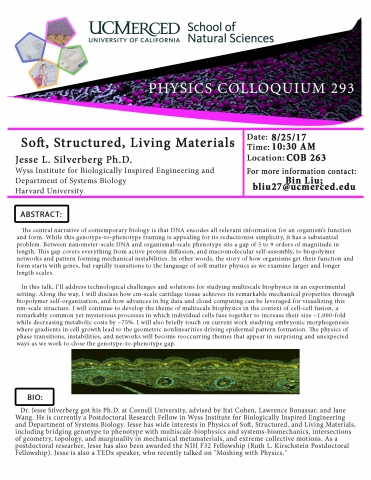
Jesse L. Silverberg Ph.D., Harvard University
Abstract:
The central narrative of contemporary biology is that DNA encodes all relevant information for an organism's function and form. While this genotype-to-phenotype framing is appealing for its reductionist simplicity, it has a substantial problem. Between nanometer-scale DNA and organismal-scale phenotype sits a gap of 5 to 9 orders of magnitude in length. This gap covers everything from active protein diffusion, and macromolecular self-assembly, to biopolymer networks and pattern forming mechanical instabilities. In other words, the story of how organisms get their function and form starts with genes, but rapidly transitions to the language of soft matter physics as we examine larger and longer length scales.
In this talk, I'll address technological challenges and solutions for studying multiscale biophysics in an experimental setting. Along the way, I will discuss how cm-scale cartilage tissue achieves its remarkable mechanical properties through biopolymer self-organization, and how advances in big data and cloud computing can be leveraged for visualizing this nm-scale structure. I will continue to develop the theme of multiscale biophysics in the context of cell-cell fusion, a remarkably common yet mysterious processes in which individual cells fuse together to increase their size -1,000-fold while decreasing metabolic costs by -75%. I will also briefly touch on current work studying embryonic morphogenesis where gradients in cell growth lead to the geometric nonlinearities driving epidermal pattern formation. The physics of phase transitions, instabilities, and networks will become reoccurring themes that appear in surprising and unexpected ways as we work to close the genotype-to-phenotype gap.




